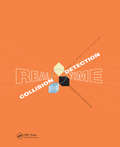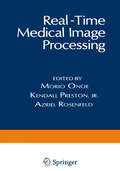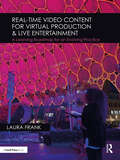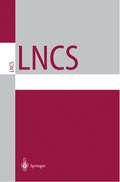- Table View
- List View
Real-time 3D Character Animation with Visual C++
by Nik LeverDo you have some experience and a reasonable knowledge of C++ and want to write your own computer games? Have you ever looked at a PC or Playstation (R) game with characters running and leaping through an exciting landscape and wondered how it was done? If so then this book will give you all the information you need to achieve this goal, whether you are a hobby programmer, student or even a professional wanting to add that third dimension to your website.Nik Lever takes you through the journey from the basics of 3D manipulation all the way to morph objects and sub-division surfaces. On the way you get Visual C++ project files to study and software that runs on the Windows desktop. The free CD-ROM gives you a full-featured development environment for 3D character animation, so even if you find some of the maths and the code hard to follow straight away you can still create your own games. The game engine (Toon3DCreator) provided free and fully functional on the CD-ROM, even has an ActiveX control that allows you to distribute your work on the Internet. All source code for Toon3D is included on the CD. You will also get an insight into the artist's problems; learn how to keep the characters interesting while not exhausting the game engine. Understand the complete picture and make the most of your skills to help you succeed in, or break into the computer gaming industry with this comprehensive guide to programming for real-time 3D character animation.
Real-time 3D Character Animation with Visual C++
by Nik LeverDo you have some experience and a reasonable knowledge of C++ and want to write your own computer games? Have you ever looked at a PC or Playstation (R) game with characters running and leaping through an exciting landscape and wondered how it was done? If so then this book will give you all the information you need to achieve this goal, whether you are a hobby programmer, student or even a professional wanting to add that third dimension to your website.Nik Lever takes you through the journey from the basics of 3D manipulation all the way to morph objects and sub-division surfaces. On the way you get Visual C++ project files to study and software that runs on the Windows desktop. The free CD-ROM gives you a full-featured development environment for 3D character animation, so even if you find some of the maths and the code hard to follow straight away you can still create your own games. The game engine (Toon3DCreator) provided free and fully functional on the CD-ROM, even has an ActiveX control that allows you to distribute your work on the Internet. All source code for Toon3D is included on the CD. You will also get an insight into the artist's problems; learn how to keep the characters interesting while not exhausting the game engine. Understand the complete picture and make the most of your skills to help you succeed in, or break into the computer gaming industry with this comprehensive guide to programming for real-time 3D character animation.
Real-Time 3D Graphics with WebGL 2: Build Interactive 3d Applications With Javascript And Webgl 2 (opengl Es 3. 0), 2nd Edition
by Farhad GhayourThis book is a complete course on computer graphics covering topics such as rendering, 3D math, lighting, cameras, and much more. It will be your trust-worthy companion in developing immersive experiences with WebGL, a hardware-accelerated technology in the browser without installing additional software.
Real Time Cameras: A Guide for Game Designers and Developers
by Mark Haigh-HutchinsonThe control of cameras is as important in games as it is in cinema. How the camera tracks and moves determines our point of view and influences our attitude towards the content. A poorly designed camera system in a game can disrupt a users experience, while a well-designed one can make a good game into a great one. The challenge in games is that th
Real-Time Collision Detection
by Christer EricsonWritten by an expert in the game industry, Christer Ericson's new book is a comprehensive guide to the components of efficient real-time collision detection systems. The book provides the tools and know-how needed to implement industrial-strength collision detection for the highly detailed dynamic environments of applications such as 3D games, virt
Real-Time Collision Detection
by Christer EricsonWritten by an expert in the game industry, Christer Ericson's new book is a comprehensive guide to the components of efficient real-time collision detection systems. The book provides the tools and know-how needed to implement industrial-strength collision detection for the highly detailed dynamic environments of applications such as 3D games, virt
Real-Time Graphics Rendering Engine (Advanced Topics in Science and Technology in China)
by Hujun Bao Wei Hua"Real-Time Graphics Rendering Engine" reveals the software architecture of the modern real-time 3D graphics rendering engine and the relevant technologies based on the authors’ experience developing this high-performance, real-time system. The relevant knowledge about real-time graphics rendering such as the rendering pipeline, the visual appearance and shading and lighting models are also introduced. This book is intended to offer well-founded guidance for researchers and developers who are interested in building their own rendering engines. Hujun Bao is a professor at the State Key Lab of Computer Aided Design and Computer Graphics, Zhejiang University, China. Dr. Wei Hua is an associate professor at the same institute.
Real-Time Heterogeneous Video Transcoding for Low-Power Applications
by Tarek Elarabi Ahmed Abdelgawad Magdy BayoumiThis book introduces a novel transcoding algorithm for real time video applications, designed to overcome inter-operability problems between MPEG-2 to H.264/AVC. The new algorithm achieves 92.8% reduction in the transcoding run time at a price of an acceptable Peak Signal-to-Noise Ratio (PSNR) degradation, enabling readers to use it for real time video applications. The algorithm described is evaluated through simulation and experimental results. In addition, the authors present a hardware implementation of the new algorithm using Field Programmable Gate Array (FPGA) and Application-specific standard products (ASIC).• Describes a novel transcoding algorithm for real time video applications, designed to overcome inter-operability problems between H.264/AVC to MPEG-2; • Implements algorithm presented using Field Programmable Gate Array (FPGA) and Application-specific Integrated Circuit (ASIC);• Demonstrates the solution to real problems, with verification through simulation and experimental results.
Real-Time Progressive Hyperspectral Image Processing: Endmember Finding and Anomaly Detection
by Chein-I ChangThe book covers the most crucial parts of real-time hyperspectral image processing: causality and real-time capability. Recently, two new concepts of real time hyperspectral image processing, Progressive HyperSpectral Imaging (PHSI) and Recursive HyperSpectral Imaging (RHSI). Both of these can be used to design algorithms and also form an integral part of real time hyperpsectral image processing. This book focuses on progressive nature in algorithms on their real-time and causal processing implementation in two major applications, endmember finding and anomaly detection, both of which are fundamental tasks in hyperspectral imaging but generally not encountered in multispectral imaging. This book is written to particularly address PHSI in real time processing, while a book, Recursive Hyperspectral Sample and Band Processing: Algorithm Architecture and Implementation (Springer 2016) can be considered as its companion book.
Real-Time Recursive Hyperspectral Sample and Band Processing: Algorithm Architecture and Implementation
by Chein-I ChangThis book explores recursive architectures in designing progressive hyperspectral imaging algorithms. In particular, it makes progressive imaging algorithms recursive by introducing the concept of Kalman filtering in algorithm design so that hyperspectral imagery can be processed not only progressively sample by sample or band by band but also recursively via recursive equations. This book can be considered a companion book of author’s books, Real-Time Progressive Hyperspectral Image Processing, published by Springer in 2016.
Real-Time Rendering, Fourth Edition
by Eric Haines Duane C. Abbey Naty HoffmanThoroughly updated, this fourth edition focuses on modern techniques used to generate synthetic three-dimensional images in a fraction of a second. With the advent of programmable shaders, a wide variety of new algorithms have arisen and evolved over the past few years. This edition discusses current, practical rendering methods used in games and o
Real-Time Rendering, Fourth Edition: High-quality And Real-time Rendering With Dxr And Other Apis
by Eric Haines Duane C. Abbey Naty HoffmanThoroughly updated, this fourth edition focuses on modern techniques used to generate synthetic three-dimensional images in a fraction of a second. With the advent of programmable shaders, a wide variety of new algorithms have arisen and evolved over the past few years. This edition discusses current, practical rendering methods used in games and o
Real-Time Shader Programming (The Morgan Kaufmann Series in Computer Graphics)
by Ron FosnerNow that PC users have entered the realm of programmable hardware, graphics programmers can create 3D images and animations comparable to those produced by RenderMan's procedural programs—-but in real time. Here is a book that will bring this cutting-edge technology to your computer. Beginning with the mathematical basics of vertex and pixel shaders, and building to detailed accounts of programmable shader operations, Real-Time Shader Programming provides the foundation and techniques necessary for replicating popular cinema-style 3D graphics as well as creating your own real-time procedural shaders. A compelling writing style, color illustrations throughout, and scores of online resources make Real-Time Shader Programming an indispensable tutorial/reference for the game developer, graphics programmer, game artist, or visualization programmer, to create countless real-time 3D effects.* Contains a complete reference of the low-level shader language for both DirectX 8 and DirectX 9 * Provides an interactive shader demonstration tool (RenderMonkeyTM) for testing and experimenting * Maintains an updated version of the detailed shader reference section at www.directx.com * Teaches the latest shader programming techniques for high-performance real-time 3D graphics
Real-Time Shading
by Marc Olano John Hart Wolfgang Heidrich Michael McCoolThis book covers real-time shading systems, their design and how they work. Procedural shading, long valued for off-line rendering and production animation is now possible on interactive graphics hardware. These developments are important for areas such as game development, product design, and scientific visualization, among others. The authors inc
Real-Time Shadows
by Elmar Eisemann Michael Schwarz Ulf Assarsson Michael WimmerImportant elements of games, movies, and other computer-generated content, shadows are crucial for enhancing realism and providing important visual cues. In recent years, there have been notable improvements in visual quality and speed, making high-quality realistic real-time shadows a reachable goal. Real-Time Shadows is a comprehensive guide to t
Real-Time Video Content for Virtual Production & Live Entertainment: A Learning Roadmap for an Evolving Practice
by Laura FrankReal-Time Video Content for Virtual Production & Live Entertainment looks at the evolution of current software and hardware, how these tools are used, and how to plan for productions dependent on real-time content. From rock concerts to theatre, live television broadcast to film production, art installations to immersive experiences, the book outlines the various applications of real-time video content – the intersection of gaming and performance that is revolutionizing how films are made and how video content is created for screens. Rather than render out a fixed video file, new tools allow for interactive video content that responds to audience activity, camera position, and performer action in real time. Combining software renderers with environmental information, video content is generated nearly instantaneously to simulate depth, creating a new world of Virtual Production. This book provides an overview of the current software and hardware used to create real-time content while also reviewing the various external technologies the real-time content is dependent upon. Case studies from industry experts appear in each chapter to reinforce the tools described, establish industry practice, and provide insight on a complex and rapidly growing discipline. Real-Time Video Content for Virtual Production & Live Entertainment prepares students and practitioners for a future working with real-time technologies and informs current entertainment technology professionals how to rethink about their old roles using these new tools. The book includes access to a companion website featuring web-based and video resources that expand on topics covered in the text. Each chapter has a unique page that points to example material, video presentations, and professional studies on chapter topics. You can visit the companion website at rtv-book.com.
Real-Time Video Content for Virtual Production & Live Entertainment: A Learning Roadmap for an Evolving Practice
by Laura FrankReal-Time Video Content for Virtual Production & Live Entertainment looks at the evolution of current software and hardware, how these tools are used, and how to plan for productions dependent on real-time content. From rock concerts to theatre, live television broadcast to film production, art installations to immersive experiences, the book outlines the various applications of real-time video content – the intersection of gaming and performance that is revolutionizing how films are made and how video content is created for screens. Rather than render out a fixed video file, new tools allow for interactive video content that responds to audience activity, camera position, and performer action in real time. Combining software renderers with environmental information, video content is generated nearly instantaneously to simulate depth, creating a new world of Virtual Production. This book provides an overview of the current software and hardware used to create real-time content while also reviewing the various external technologies the real-time content is dependent upon. Case studies from industry experts appear in each chapter to reinforce the tools described, establish industry practice, and provide insight on a complex and rapidly growing discipline. Real-Time Video Content for Virtual Production & Live Entertainment prepares students and practitioners for a future working with real-time technologies and informs current entertainment technology professionals how to rethink about their old roles using these new tools. The book includes access to a companion website featuring web-based and video resources that expand on topics covered in the text. Each chapter has a unique page that points to example material, video presentations, and professional studies on chapter topics. You can visit the companion website at rtv-book.com.
Real Time Visual Effects for the Technical Artist
by Chris RodaVisual effects (VFX) are one of the most complicated components of feature film and television creation. With advancements in such technologies as Ray Tracing and Virtual Reality, the visual quality of the real-time rendering engine is now rivaling feature film. Real-time rendering requires years of programming experience with advanced understanding in math and physics. As the power of the real-time rendering engine improves, so too do the interfaces for VFX creation. With limited technical understanding, artists can create VFX with the push of a button and tug of a slider. As powerful as the interfaces are, they can only expose a portion of the true potential of the rendering engine. Artists are limited by their understanding of the engine interface. Real Time Visual Effects for the Technical Artist is written for digital artists to explain the core concepts of VFX, common in all engines, to free them from interface bounds. Features: Introduces the reader to the technical aspects of real-time VFX Built upon a career of more than 20 years in the feature film VFX and the real-time video game industries and tested on graduate and undergraduate students Explores all real-time VFX in four categories: in-camera effects, in-material effects, simulations, and particles This book is written to complement undergraduate- or graduate-level courses focused on the fundamentals of modern real-time VFX. Chris Roda is a Technical Art instructor at the Florida Interactive Entertainment Academy (FIEA), a graduate degree program in interactive, real-time application development at the University of Central Florida. Early in his career, Chris was a visual effects artist in the film and television industries where he contributed visual effects for films such as Spider-Man, Titanic, and The Fifth Element. Before coming to FIEA, Chris was a CG Supervisor at Electronic Arts, where he worked on video game titles such as NCAA Football and Madden NFL Football. In addition to teaching, Chris works on generating tools and pipelines for the creation of immersive experiences: the amalgamation of the narrative of films, the interactivity of video games, and the immersion of theme parks.
Real Time Visual Effects for the Technical Artist
by Chris RodaVisual effects (VFX) are one of the most complicated components of feature film and television creation. With advancements in such technologies as Ray Tracing and Virtual Reality, the visual quality of the real-time rendering engine is now rivaling feature film. Real-time rendering requires years of programming experience with advanced understanding in math and physics. As the power of the real-time rendering engine improves, so too do the interfaces for VFX creation. With limited technical understanding, artists can create VFX with the push of a button and tug of a slider. As powerful as the interfaces are, they can only expose a portion of the true potential of the rendering engine. Artists are limited by their understanding of the engine interface. Real Time Visual Effects for the Technical Artist is written for digital artists to explain the core concepts of VFX, common in all engines, to free them from interface bounds. Features: Introduces the reader to the technical aspects of real-time VFX Built upon a career of more than 20 years in the feature film VFX and the real-time video game industries and tested on graduate and undergraduate students Explores all real-time VFX in four categories: in-camera effects, in-material effects, simulations, and particles This book is written to complement undergraduate- or graduate-level courses focused on the fundamentals of modern real-time VFX. Chris Roda is a Technical Art instructor at the Florida Interactive Entertainment Academy (FIEA), a graduate degree program in interactive, real-time application development at the University of Central Florida. Early in his career, Chris was a visual effects artist in the film and television industries where he contributed visual effects for films such as Spider-Man, Titanic, and The Fifth Element. Before coming to FIEA, Chris was a CG Supervisor at Electronic Arts, where he worked on video game titles such as NCAA Football and Madden NFL Football. In addition to teaching, Chris works on generating tools and pipelines for the creation of immersive experiences: the amalgamation of the narrative of films, the interactivity of video games, and the immersion of theme parks.
Real-Time Volume Graphics
by Daniel Weiskopf Klaus Engel Markus Hadwiger Joe Kniss Christof Rezk-SalamaBased on course notes of SIGGRAPH course teaching techniques for real-time rendering of volumetric data and effects; covers both applications in scientific visualization and real-time rendering. Starts with the basics (texture-based ray casting) and then improves and expands the algorithms incrementally. Book includes source code, algorithms, diagr
Real to Reel: A New Approach to Understanding Realism in Film and TV Fiction (Auteur)
by Marten Sohn-RethelWhat happens when we watch feature films or television dramas? Many of our responses to moving-image fiction texts embody "realism" or "truth," but what are we responding to, exactly, and how is our notion of reality or truth to be understood? For film and media students and makers of moving-image fiction in new digital forms, the question of how to get a more objective, rigorous handle on realism has never been more important. In this accessible book, Martin Sohn-Rethel brings a lifetime of teaching film and media to bear on developing a new approach to analyzing the "realism" of the moving image: a set of seven "codes" that plot this tricky field of enquiry more systematically. In doing so, he considers a wide range of film and media texts chosen for their accessibility, including Do the Right Thing (1989), In the Name of the Father (1993), Erin Brockovich (2000), and District 9 (2009).
Real to Reel: A New Approach to Understanding Realism in Film and TV Fiction (Auteur)
by Martin Sohn-RethelWhat happens when we watch feature films or television dramas? Many of our responses to moving-image fiction texts embody "realism" or "truth," but what are we responding to, exactly, and how is our notion of reality or truth to be understood? For film and media students and makers of moving-image fiction in new digital forms, the question of how to get a more objective, rigorous handle on realism has never been more important. In this accessible book, Martin Sohn-Rethel brings a lifetime of teaching film and media to bear on developing a new approach to analyzing the "realism" of the moving image: a set of seven "codes" that plot this tricky field of enquiry more systematically. In doing so, he considers a wide range of film and media texts chosen for their accessibility, including Do the Right Thing (1989), In the Name of the Father (1993), Erin Brockovich (2000), and District 9 (2009).
Real VR – Immersive Digital Reality: How to Import the Real World into Head-Mounted Immersive Displays (Lecture Notes in Computer Science #11900)
by Marcus Magnor Alexander Sorkine-HornungWith the advent of consumer-market Virtual Reality (VR) technology, the next revolution in visual entertainment is already on the horizon: real VR will enable us to experience live-action movies, sports broadcasts, concert videos, etc. in true visual (and aural) immersion. This book provides a comprehensive overview of the algorithms and methods that make it possible to immerse into real-world recordings. It brings together the expertise of internationally renowned experts from academia and industry who present the state of the art in this fascinating, interdisciplinary new research field. Written by and for scientists, engineers, and practitioners, this book is the definitive reference for anyone interested in finding out about how to import the real world into head-mounted displays.
Real-World Applications of Evolutionary Computing: EvoWorkshops 2000: EvoIASP, EvoSCONDI, EvoTel, EvoSTIM, EvoRob, and EvoFlight, Edinburgh, Scotland, UK, April 17, 2000 Proceedings (Lecture Notes in Computer Science #1803)
by Stefano Cagnoni Ben Paechter Terence C. Fogarty Riccardo Poli George D. Smith David Corne Martin Oates Emma Hart Pier L. Lanzi Egbert J. Willem Yun LiThe increasingly active eld of Evolutionary Computation (EC) provides val- ble tools, inspired by the theory of natural selection and genetic inheritance, to problem solving, machine learning, and optimization in many real-world app- cations. Despite some early intuitions about EC, that can be dated back to the - vention of computers, and a better formal de nition of EC, made in the 1960s, the quest for real-world applications of EC only began in the late 1980s. The dramatic increase in computer performances in the last decade of the 20th c- tury gave rise to a positive feedback process: EC techniques became more and more applicable, stimulating the growth of interest in their study, and allowing, in turn, new powerful EC paradigms to be devised. In parallel with new theoretical results, the number of elds to which EC is being applied is increasing day by day, along with the complexity of applications and application domains. In particular, industrially relevant elds, such as signal and image processing, computer vision, pattern recognition, industrial control, telecommunication, scheduling and timetabling, and aerospace engineering are employing EC techniques to solve complex real-world problems.





















